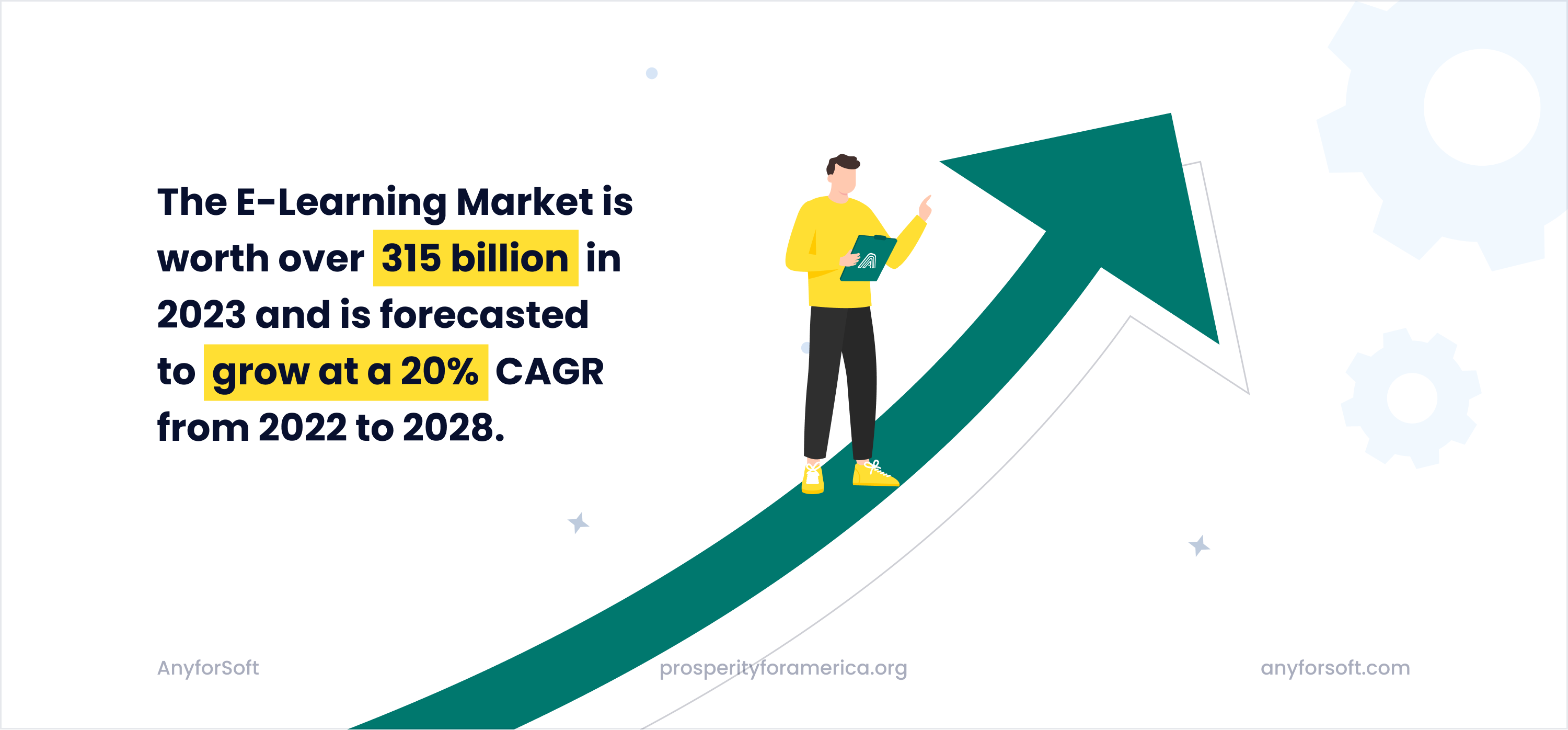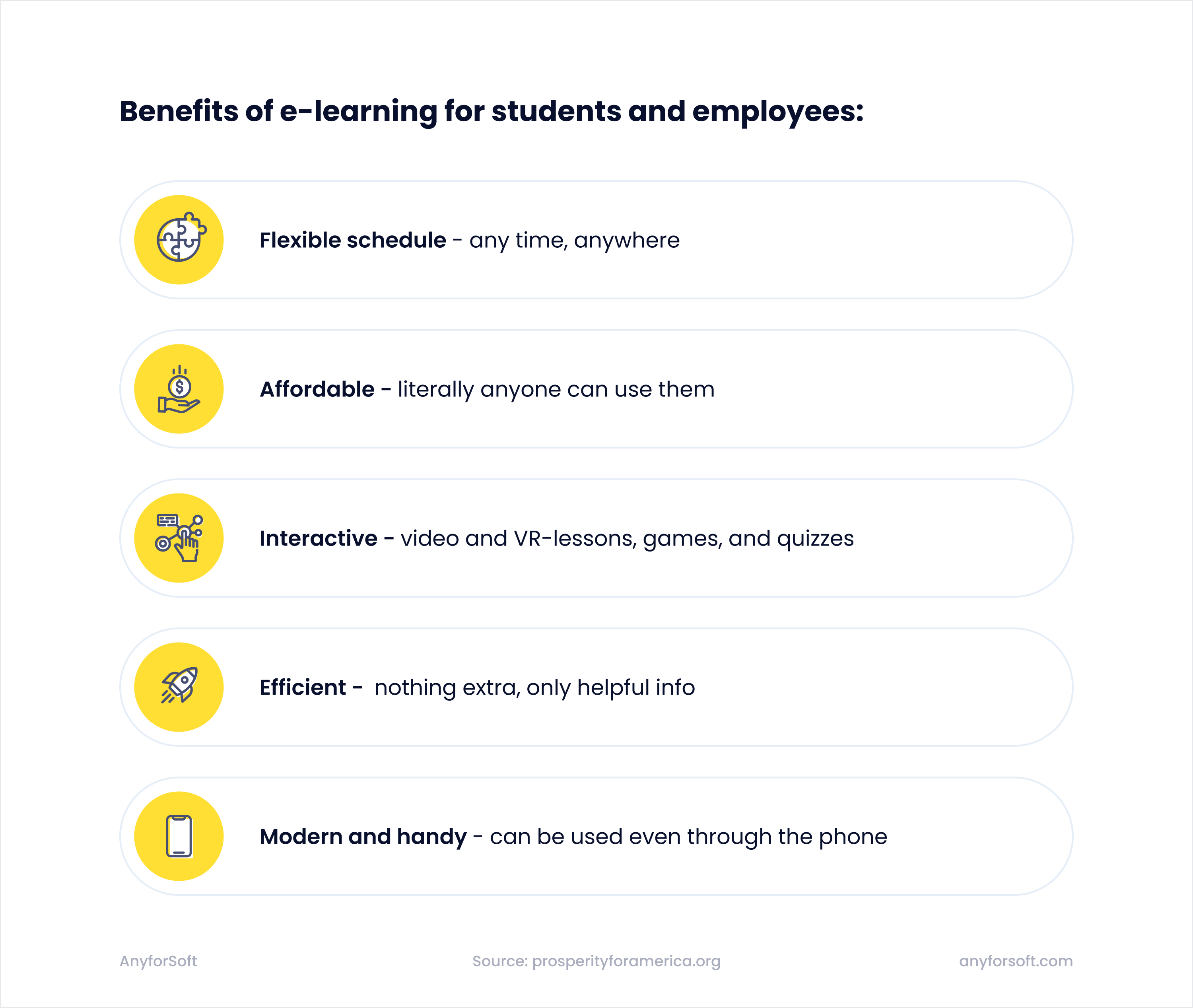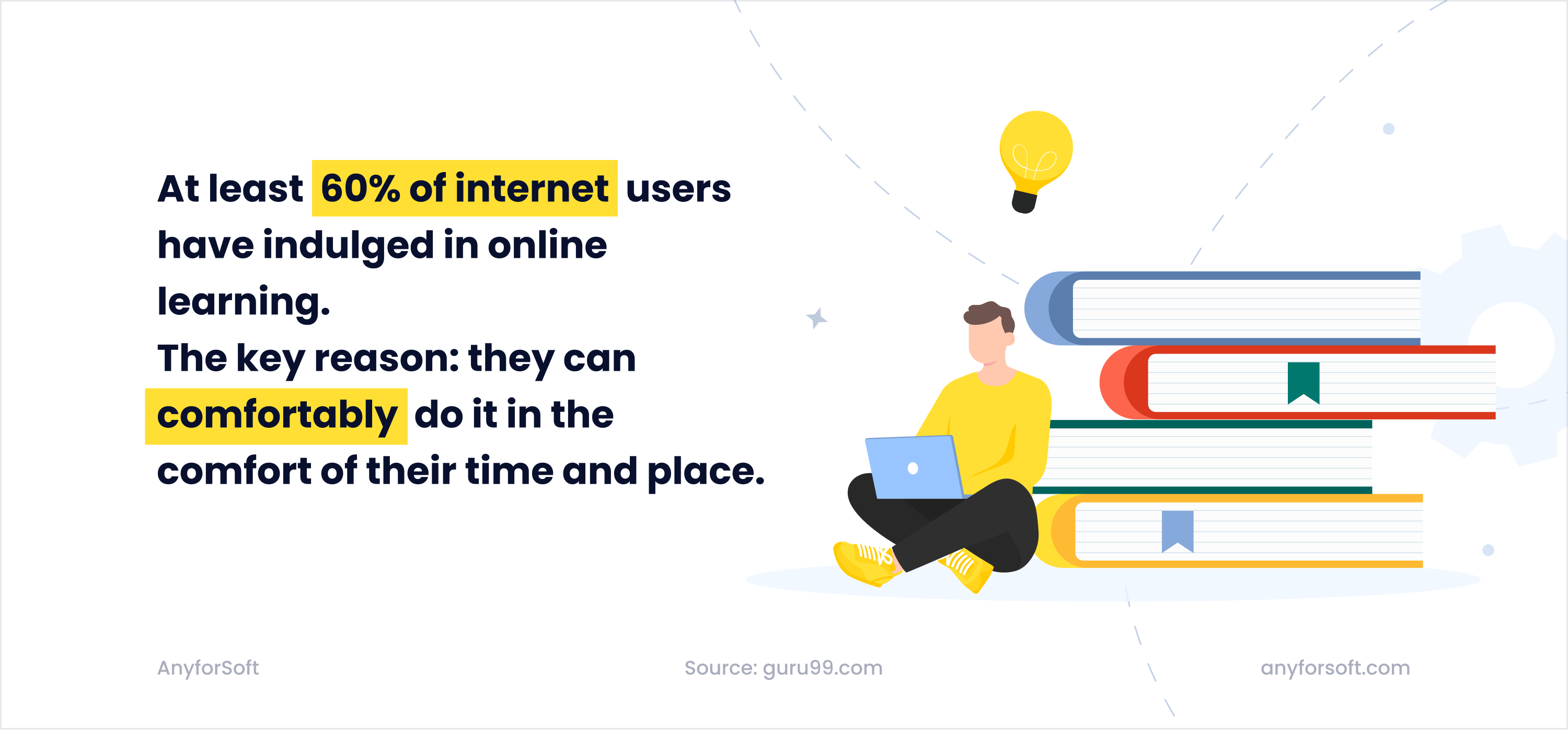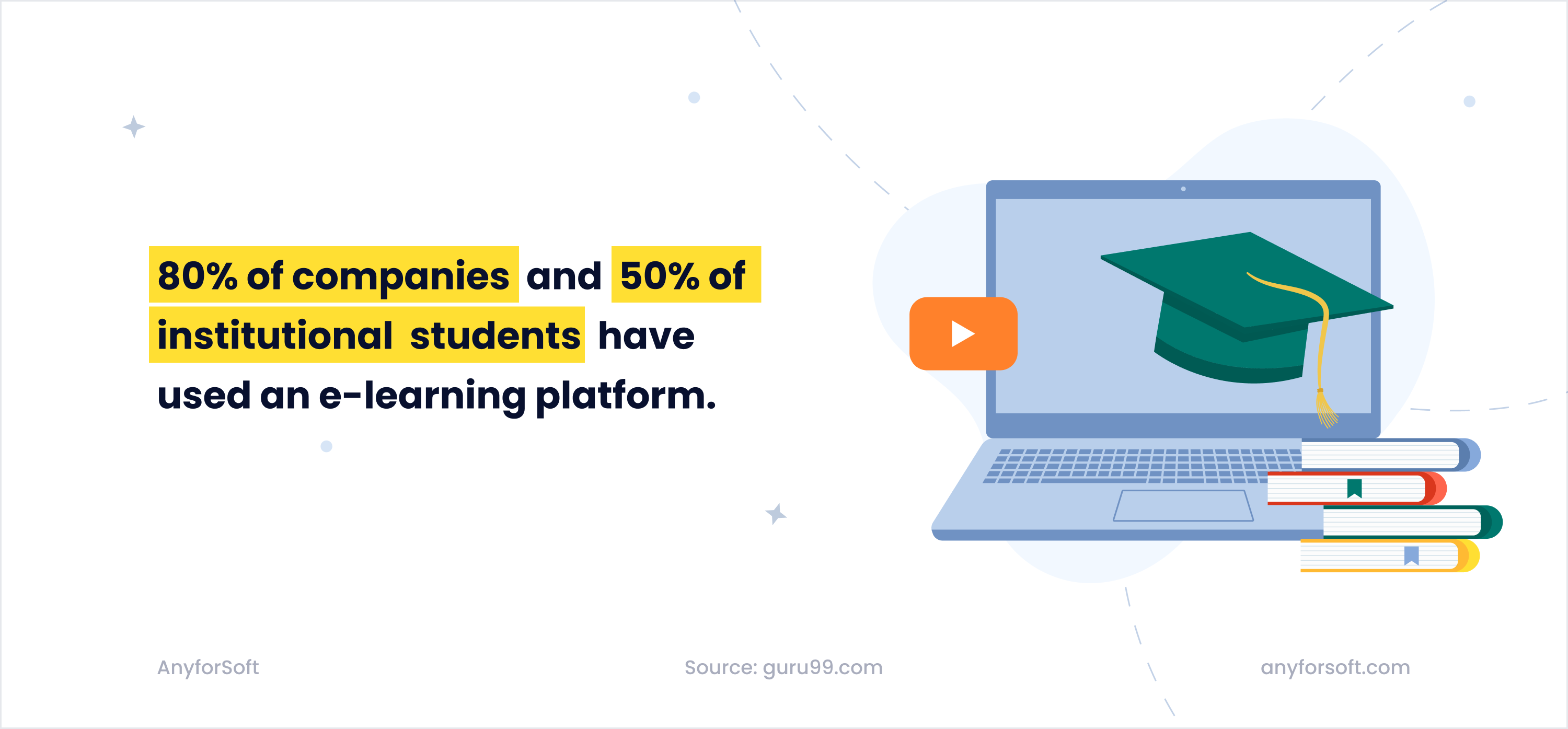A person learns all his life, from the first word or the first step, he acquires new skills and knowledge necessary for survival and new achievements. Technologies have made the learning process convenient, accessible, and straightforward. Using e-learning apps, you can get remote education, learn a language, and undergo additional professional and specialized training. But the creation of such an application is extensive and comprehensive, so as an e-learning development services provider, we decided to write this comprehensive guide. In the following paragraphs, you will learn how to make an e-learning app from scratch, including:
- What types of desktop and mobile e-learning apps exist.
- What are the key benefits of creating an e-learning solution.
- How to create an app for e-learning in 7 steps.
- What features you should add to your own own e-learning app.
- How much the development costs.
Without further ado, let's dive in!
Main Types Of E-Learning Applications
Let's start with a bit of theory and facts. E-learning is the quickest-growing market in the education sphere. Recent forecasts state that the number of online learning platform users is expected to reach 57 million by 2027, so the e-learning industry will continue to thrive. However, what types of educational apps are there?

Depending on the criterion, there are several classifications, but it is most convenient to divide them into applications for personal (individual) use, academic training, and corporate types of e-learning applications.
- Personal learning apps. You have surely seen many online courses, collected on e-learning platforms or separate applications, which offer to learn everything on your own, from mathematics to the basics of flying an airplane. This convenient learning method allows you to master knowledge at a comfortable pace with or without tutor checks. Many users note that this is a great way to try something new and find out if this or that profession suits you.
- Applications of academic training. This is a whole niche for teachers and online tutors to share their learning materials or visual presentations, provide consulting and training services, and conduct lectures. Virtual classrooms and applications for students and pupils came in handy during the pandemic. Still, after proving their effectiveness, they became a new way of remote learning in foreign educational institutions and beyond.
- Corporate education. Here is another interesting fact: nine out of ten businesses offer e-learning opportunities to their employees. Seminars have become webinars, and lectures can be viewed conveniently instead of rearranging each employee's schedule. This innovative way of training employees allows you to use the company's time and money wisely.
The popularity of online education is only growing, which is why it is so essential to grasp the idea of e-learning application development and implement it now.
Key Benefits Of E-Learning Apps
Let's admit: taking online classes can be very engaging and convenient. It's evident that people choose online learning apps for some additional skills or knowledge, but modern educational institutions offer different programs for students allowing them even get a degree in various subjects remotely. But what exactly an e-learning application can bring to the business?
- High retention rate: the latest technologies and gamification of the learning process make e-learning applications incredibly useful, practical, and attractive to the user. Instead of a boring test with tasks and a white sheet – interactive situational lessons supplemented with astonishing graphics. Add the ability to do it all on the phone with one hand, and your target audience has expanded significantly. Research shows that companies that use e-Learning solutions for employee training increase employee retention by 24%.
- High customer loyalty and satisfaction: the primary goal of any business is to turn an occasional customer into a regular one. Learning is a continuous process, but not only the variety of courses offered matters. You can add elements of customization, convenient navigation, options for people with disabilities, etc. Your arsenal is always limitless, and so are the ways to attract a client.
- Flexible monetization strategy: you can choose one-time individual payments for each course or subscription, provide additional services or bonus programs to regular customers, conduct promotions and raffles, and introduce a flexible loyalty system that would allow you to increase profits.
- Better learning outcomes: multiple studies show that online learning apps educate more effectively than traditional learning. That's because the learning process is self-paced and hence less stressed, which contributes to the effectiveness. Besides, apps offer a more personalized learning experience (with gamification elements, and so on), allowing learners to choose the learning style that best fits their personality.
- Cost-effectiveness: another benefit of online learning solutions is their cost-effectiveness. For example, IBM saved around $200 million by switching to an online learning process. Besides, building an e-learning app can help you reduce the overall learning time by 25-60%, ensuring faster corporate training.
- Flexibility: EdTech apps offer the flexibility of personalized learning. Learners have access to a vide variety of educational content and thus can find the best way to memorize new materials.
- Process automation: with e-learning app development, you can create a tool that will automate routine labor-intensive tasks, helping you save time and effort while increasing the operational efficiency of your organization. For instance, by using a learning management system, you can automate many course management and user management processes, freeing up your time for important business matters.

You will get even more from e-learning mobile app development because, according to recent surveys, 67% of American college learners have completed some, if not all, of their course activity on their mobile phones.
Steps For E-Learning App Development
E-learning application development is a long run, so be prepared that many different stages are waiting for you that you can delegate, control or directly participate in.
Step 1. Ideation. It's no secret that everything starts with a thought – an idea that is transformed into a finished product necessary for achieving business goals. Among this variety of implementation options, it is worth choosing the one that most realizes the primary idea. It may be online classes, discussion forums, video streaming, training platforms, or literally anything that helps virtual learning.
To ensure successful e-learning development, we recommend starting with the project discovery phase. The discovery is the process of researching the market and gathering information about a specific project that is carried out before kicking off its development. This initial phase is focused on identifying your target audience as well as their pain points and needs. It will then help people involved in the project understand your project idea and get a clear vision of the final product; set realistic business goals; receive business and technical requirements; get an accurate development budget estimate; meticulously plan the development process; and prevent development risks.
Step 2. Market research. At the level of idea development, directly research the market to determine needs, requests, prominent trends, target audience, and potential competitors. Your task here is to check the idea's viability, refine it, and strengthen it. This can be delegated to special agencies or full-cycle e-learning application development companies that provide such services.
Step 3. UX/UI Design. Even before the start of development, it is worth thinking through everything to the smallest detail. And this is where interactive prototypes, mockups, and frameworks come to the rescue, helping to bring the idea to life and visualize it literally. An experienced development team will help you with basic options and advanced features, but you also need to have a vision of the future product that is clear enough to sketch. Usability and the basics of the interface are laid out precisely at this step.
Step 4. Minimal viable product. While full-cycle development using an agile methodology saves you time, the first thing you get is an MVP. This is not yet a finished product that can be launched and placed on the application stores or the website, but it is a good version for the first tests. Many companies perceive this as a starting point for further development of a full-fledged product because, at this stage, you can find out the program's pitfalls, weak points, and shortcomings.
Step 5. App features. As already mentioned above, you can vary the functionality of the application and the platform. The basic set can be expanded with specially developed or ready-made solutions already widely used in the industry.
Step 6. Monetization. Four main monetization schemes are acceptable for e-learning apps: in-app advertising, subscriptions, paid access to individual course blocks (certification), and e-commerce integration. You can choose one, or a combination of several, that best suits your idea. The e-learning app developers will consider this and integrate it into education apps during the app development process.
Step 7. Testing. Best practices encourage comprehensive testing, manual and automated, by beta users. It is necessary to ensure that the application works properly before publishing it on the App Store or Google Play. If everything is fine and no bugs are found, the application is ready for launch, and the next step is support and maintenance.
An E-learning app development company can become your partner at any step. However, it is recommended to entrust development to an expert development team from scratch to avoid unnecessary and annoying problems with code.
Must-Have Features Of Online Learning Apps
Despite applications' different types and functionality, certain app features are inherent – and should be – in each of them. Consider paying attention to:
- Simple and easy registration, preferably through social networks, to reduce the user's time as much as possible.
- Customization has been a must-have for a long time, and although the personal account of a teacher and a student will usually differ, choosing a theme or setting the external view is mandatory.
- Push notifications. The app should notify users of new events, but it should be a flexible, customizable option that allows you to select only the reminders you need, not all of them.
- Navigation is also an integral element of all applications. Convenient, simple, transparent, and intuitive.
- Feedback, personal and for the entire course. In general, it is necessary for all participants in the educational process and can be implemented as a comment panel or a separate block for collecting opinions and feedback.
- Course Management. Users and tutors should be able to add and delete educational courses, control who has access to them, edit learning content, distribute it, manage files in various formats, including PDF presentations, video, audio, and so on.
- Reports And Analytics. Your e-learning mobile app should provide comprehensive reports and analytics on learners’ progress, performance, attendance, and relevant data. That will allow for better control of the education process and help improve your online courses as well as the learning experience.
- Cross-Platform Compatibility. Ensure your application is well-optimized for various devices and operating systems. Allow users to study from their preferred device for a better learning experience and personalized learning process.
- Progress Indicators. To develop an e-learning app that is engaging, give users an idea of how far they’ve progressed in their learning paths. Provide learners with a sense of achievement to keep them motivated and minimize the risk of them abandoning education.
- User Management. Mobile apps for e-learning should allow you to add and delete users, assign them specific roles, combine them into groups, create logins and passwords for your learners, and perform other user management actions.
Student Panel Features
First, student panel features should have access to all study materials, such as lessons and lectures, presentations, video lessons, audio, etc. The ticket can be opened and closed depending on the selected plan or validity period.
Games, quizzes, tests. It is vital that it was built according to the principle of training, but in a game form, one should not forget about the main option of the platform - learning.
Student performance and analysis system. The ability to see your progress and statistics over a certain period helps you study and motivates you to improve your results.
Communication in the application. The exchange of ideas, requests, or discussion of tasks is an essential element of joint work, collaboration, and communication with a mentor. Messaging or video calls are reasonable solutions.
Payment gateway. Depending on the chosen method of monetization, you may need to integrate different payment systems, such as Google Pay, Apple Pay, and PayPal, or the development of an individual.

Teachers Panel Features
Most of the applications where teachers are involved are interactive, so the teacher's panel needs to pay attention to the possibilities of working with content: adding, removing, updating, saving, and managing any content intended for the educational process.
Libraries are in demand, in which the teacher can store his materials or answers to tests, which are not available to students but are always at hand.
Ability to check, comment, evaluate students' work and give and receive feedback. As well as contacting students and teachers through texts, video, or audio. The interactivity of communication as a whole should be optional.
Video conferencing as one of the ways to hold a lesson with a group of students or individuals.
The ability to post instructions and comments to students in the profile and 'workbooks' to help students.
Admin Panel Features
As the name suggests, the admin panel is essential for learning arbitration and management options. If it is an educational platform, the administrator can be the platform's owner, who manages all users' access and opportunities.
However, parents can also be administrators, who should also have access to educational materials and their child's performance. In this case, there should be unique options.
Push notifications for all significant events, such as the beginning and end of the lesson, student presence, grades, and test reminders.
Ability to track progress and attendance of lessons and courses.
Communication with the teacher or supervisor to discuss critical points.
Gamification
Gamification in online learning is adding game-like elements and gaming mechanics to online learning platforms.
These elements include:
- achievement badges;
- leadership boards;
- various points;
- progress indicators;
- mini-games;
- quizzes, and so on.
Gamification has numerous advantages. First of all, gamification leads to better learning outcomes. Numerous studies indicate that those who learn with gamification elements perform better on tests compared to those who learn in more traditional learning settings. Secondly, gamification increases learner engagement and retention. With gamified mechanics, learning apps can even win the attention of those who don’t like studying at all, which is a significant advantage. So if you want to provide the best learning experience, you should create an app with gamification in mind.
How Much Does It Cost To Develop An E-Learning App?
Unfortunately, there is no simple answer here. Of course, there is a price and an approximate app development cost, however, too many factors affect the final cost of e-learning mobile app development. Like this:
- Project complexity: depending on the type and size of the mobile application or learning platform, you may need different specialists, and their number also varies. For example, native or cross-platform development to ensure your app is accessible on any mobile device can have different estimations.
- Design: although a simple enough template is usually chosen, the user-friendly interface is of great importance, and designing individual icons or blocks can take significantly more time than using ready-made solutions
- Functionality: yes, this is also about the complexity of the idea. If, for the implementation of your project, you need to develop a new or transform an old solution and add many options not provided by the basic set, the development cost will also increase.
- Location of the team: it is known that hiring development centers and companies in Eastern Europe and Asia will cost less than in Western Europe or the United States, which can reduce costs.
- Support and any additional options: a full-cycle development company offers marketing research, business analyses, in-depth testing, support, and maintenance. It is not surprising that all these are extra expenses.
- Technology stack: some technologies are rare and require very specific expertise to use. Thus, the technology stack directly impacts the cost of e-learning mobile app.
- Expertise of the team: the expertise of the team you are going to hire will also impact the total cost.
Considering all this, it is difficult to call the final e-learning app development cost, relying only on general examples and standardized tariffs. After all, you can also choose a model of cooperation with a team or company, which will also affect the final amount.
Anyforsoft's Expertise In E-Learning App Development
When developing an e-learning solution, we consider all possible factors with customer requirements as a starting point. You can learn more about our projects in the portfolio, we have developed different educational products for small, medium, and enterprise clients. For example, we helped a German-language educational online portal achieve an 18% traffic increase, get 10% more subscribers, and increase website speed by 31%.
We strive to build applications to transform the learning experience into engaging and exciting journey. Based on our solid mobile app development expertise, we choose the best-suited technologies, like programming languages, frameworks, plugins, etc., to create state-of-the-art applications and platforms.
We connect teachers and students by providing a convenient, flexible, and interactive learning environment. It is crucial for our development team to meet expectations and surpass them.
Moreover, we stay with our clients after delivery and lunch of the app, providing support and maintenance to ensure it operates smoothly and seamlessly.

Summary
Given the rapid growth and development of the e-learning industry, it is only a matter of time before all processes become available online. You can be among the pioneers moving the industry and setting the trends. As you can see, the key to success is a unique idea that solves specific problems and challenges of users and its successful implementation. And if the first depends on you, then an experienced and reliable development company will help you with the second. Feel free to contact our managers to discuss the project or estimate its costs. We are open to cooperation and will gladly help you along the way by creating an effective product development team that cares about the result from the very first step. Having over 12 years of development experience, we deliver projects of any complexity.
FAQs
The prominent examples of e-learning include language learning apps, online courses, video courses and training platforms, Google Classroom, etc.
The prominent examples of e-learning include language learning apps, online courses, video courses and training platforms, Google Classroom, etc.
The development time directly depends on the complexity of the idea. The more complex the idea, the longer will be its full implementation, but the MVP can be created in a shorter time.
The development time directly depends on the complexity of the idea. The more complex the idea, the longer will be its full implementation, but the MVP can be created in a shorter time.
Among the main monetization methods, certification, advertising in the application, subscriptions are most often chosen. You can select one of the methods or several.
Among the main monetization methods, certification, advertising in the application, subscriptions are most often chosen. You can select one of the methods or several.
That will depend on the type of app you aim to build and the features you want it to support. Here are some examples of technologies you can use to build an e-learning mobile app:
Front-End Technologies
For Android app: Java or Kotlin
For iOS app: Swift or Objective-C
Back-End technologies
PHP or Node.js
Database
MySQL
Third-Party Services
Registration: Google Sign-In, Facebook SDK
Mailing: Mailchimp
Payment Gateway: Square API, Braintree, Stripe,
Push Notifications: Firebase Cloud Messaging
Cloud: AWS, Azure
Our team will help you choose the right stack depending on your product vision and business requirements, so don't hesitate to contact us via the website form.
That will depend on the type of app you aim to build and the features you want it to support. Here are some examples of technologies you can use to build an e-learning mobile app:Front-End Technologies For Android app: Java or Kotlin For iOS app: Swift or Objective-C Back-End technologies PHP or Node.js Database MySQL Third-Party Services Registration: Google Sign-In, Facebook SDK Mailing: Mailchimp Payment Gateway: Square API, Braintree, Stripe, Push Notifications: Firebase Cloud Messaging Cloud: AWS, Azure Our team will help you choose the right stack depending on your product vision and business requirements, so don't hesitate to contact us via the website form.
The e-learning industry encompasses a plethora of e-learning solutions for great learning experience, the most popular are:
- Learning management systems.
- Learning experience platforms.
- School management solutions.
- Virtual classrooms.
- Language learning applications.
- Knowledge management tools.
- Corporate training systems.
- Proctoring software.
The e-learning industry encompasses a plethora of e-learning solutions for great learning experience, the most popular are: Learning management systems. Learning experience platforms. School management solutions. Virtual classrooms. Language learning applications. Knowledge management tools. Corporate training systems. Proctoring software.
